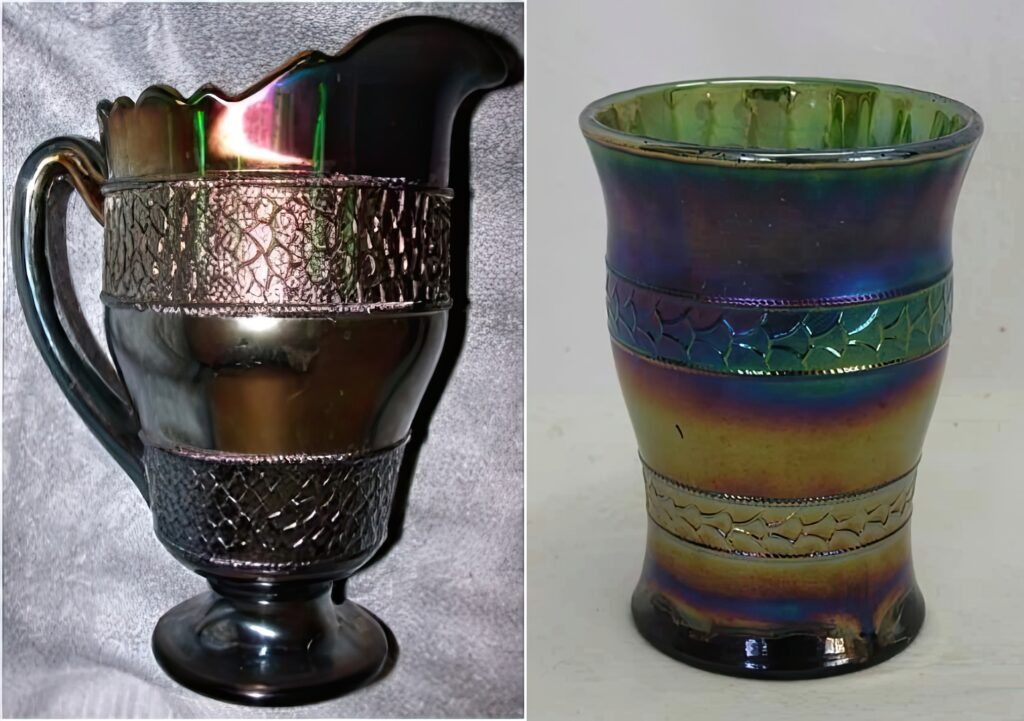Scale Band
By Barb Chamberlain
The Scale Band pattern is probably not everyone’s idea of an exciting pattern, but it is an interesting pattern found in several shapes. It was produced by the Fenton Art Glass Company. It was named for the bands, top and bottom, that incorporate Fenton’s patented scales filler.
This pattern can be found as the primary pattern on pitchers and tumblers, but is also found on the exterior of some of Fenton’s Stippled Rays pieces.
Until recently, the only colors that the pitcher and tumblers were known were marigold and blue, with blue being quite a scarce color. Within the last few years, we purchased a green water pitcher and tumbler. The color on these might be more accurately described as a dark teal green. Diane Fry shows a green pitcher and tumbler on Carnival Glass 101, as well. Other than blue, marigold, and green, tumblers have been found in vaseline and a lightly iridized aqua base color.
The green Scale Band pitcher and tumbler are pictured above. There are very few of these green pitchers and tumblers known.
Unlike the bowls and plates, the interiors of the pitchers and tumblers feature a Smooth Rays interior. The bowls and plates have the stippling on alternating rays.
The bowls and plates that are found are called Stippled Rays because they were named for the primary pattern on the interior of the bowls. You will have to turn pieces over to determine if the Scale Band pattern is present as the exterior pattern. A lot of Stippled Rays pieces have a plain exterior.

The small plate, shown on the left, shows the Stippled Rays pattern found on the interior of the Scale Band back pattern, shown on the right.
The most commonly found pieces in the Stippled Rays/Scale Band pattern are the small bowls which are about five and one-half or six inches in diameter. These are found in amber, aqua (teal), amberina, blue, lime green, marigold, red, reverse amberina, and white. Emmett and Dorothy Morgan found a true vaseline colored berry bowl. Other colors are a possibility, especially if we don’t know if any of the other Stippled Rays pieces that sold might have had the Scale Band exterior.
Large bowls have been reported selling in marigold and white. Dave Doty shows an ice blue one that King Hoppel shared. There is a full berry set in marigold that was listed as selling. These large bowls can be found ruffled or round and measure about nine and one-quarter to eleven inches in diameter.
The two sizes of bowls, master and berry bowl appear to be ice blue and white. But in reality the photo below shows them both to be white. There is a tinge of blue in the base color, but to the naked eye, they are both white. Could the same thing have happened to King Hoppel when he took his photo of the ice blue one that is on the Doty website?
Possibly the most collectible of the Stippled Rays/Scale Band pieces to collect are the small plates which measure about six and one-half to seven inches in diameter. They have sold in amber, green, marigold, pink, red, and teal green. These small plates were most likely made from the same mold as the small bowls, which when still malleable were flattened by the finisher with an apple wood paddle.
Wouldn’t it be great, if somewhere there was a chop plate in this pattern? If there was one made, it could have been flattened by the finisher from the large bowl mold. Keep looking. It may be out there.
There is a true vaseline berry bowl known, but the one on the left in the photo is a lime green bowl that glows. It is shown with the white berry bowl to show that the lime green bowl has only one Scale Band. Either this was done earlier than the two-‐band mold or was one of the later ones that didn’t show the pattern well because of wear to the mold. It is fun to find little differences with the mold work. Above right is a ruffled red or amberina berry bowl.
If you have another color or shape in any of these Scale Band pieces, please write to me and include a photo, if possible, at dbcham@iowatelecom.net or 124 E. Honey Creek Dr., Manchester, IA 52057. I would like to share it in an update of The Carnival Pump.
This article first appeared in the ICGA Pump in the December 2016 issue and is reprinted with permission.





